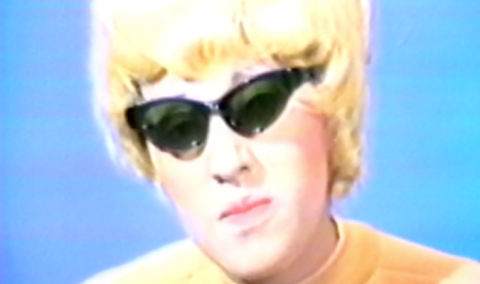Known for deconstructing unconventional materials and reconstructing personal and cultural memories in her work, the artist Howardena Pindell has had a distinguished career and continues to educate and enlighten viewers with her art. Pindell studied painting at Boston University, where she received a BFA in 1965, and attended Yale University, where she received an MFA in 1967. In 1969, she took a job as an exhibition assistant at the Museum of Modern Art and worked her way up to associate curator of Prints and Illustrated Books.
Immersed in the New York art scene, Pindell became inspired by the developments in abstract art of the time and moved away from her early figurative style. She began to experiment with abstraction, in particular circles and grids, in the early 1970s. Pindell cut her canvases into squares to stitch them back together into grids and punched holes in paper to create stencils. As the punched dots accumulated, she began to incorporate them into her work, layering them with acrylic paint to form sculptural, textured surfaces, and added glitter and sequins to further complicate the effects of light and dimensionality.
In 1979, Pindell left her position at MoMA to join the faculty at SUNY Stony Brook, where she continues to work today. The same year, she was in a near fatal car crash that left her with head trauma and memory loss. Pindell’s efforts to recall her past fed into her artwork and, in the 1980s, she began an “Autobiography” series, which incorporated outlines of her own body as well as personal items, such as postcards from her friends and travels. By the 1990s, Pindell was tackling larger social and political issues, denouncing racism, sexism, and colonialism, as well as AIDS, slavery, apartheid, and sweatshop labor, while still experimenting with form, color, and process, as she continues to do in her current work.
Pindell’s mining of personal and cultural histories began with her celebrated video Free, White and 21 (1980). Created eight months after her car accident, the production helped Pindell heal and recall moments from her past. This figures as a transitional point in her career, as it encouraged her to continue exploring the autobiographical in her artwork.
The twelve-minute video features Pindell in two roles—as herself, detailing experiences growing up as a Black woman in America, and as an anonymous White female character (wearing a blonde wig, white powder, and sunglasses) responding to those accounts. The format is part-confessional with scenes of Pindell speaking plainly to the camera as she recounts subtle and overt instances of racism she experienced from childhood to the present, in all areas of daily life—at school, work, and leisure. These segments then cut to the White female character, who is dismissive of these events, calling Pindell “paranoid” and “ungrateful” while ironically asserting her privilege of being “free, white, and 21.” And interwoven through these exchanges are views of Pindell wrapping and then unwrapping her head with white bandages and peeling off a facial mask, likely references to Pindell’s accident, White standards of beauty, and desires for (as well as the futility and impossibility of) assimilation.
The work speaks to the tensions between Black and White feminists in the 1970s, when feminism oriented around the idea of “woman” as White and middle class, and how those dynamics bled into the art world, making it difficult for Pindell to find venues to exhibit her work. She recalls,
I decided to make Free, White and 21 after yet another run-in with racism in the art world and the White feminists. I was feeling very isolated as a token artist. I found that White women wanted me to be limited to their agenda.... I was told I was jealous because I noticed and talked about it. Racism, as a constant assault in the daily lives of all people of color, was not a high priority for them.... It was about domination and the erasure of experience, canceling and rewriting history in a way that made one group feel safe and not threatened…. In the tape, I was bristling at the women’s movement as well as at the art world and some of the usual offensive encounters that were heaped on top of the racism of my profession.
At the same time, the exhibition of Pindell’s video is especially timely now, in the wake of worldwide protests for racial justice sparked by the death of George Floyd in May 2020. More Americans are aware of how racism operates on macro and micro levels and are interested in listening to and learning from the experiences of Black Americans, such as Pindell. Forty years ago, she bravely shared her painful past, and now it seems we finally are ready to receive it. –Kanitra Fletcher

